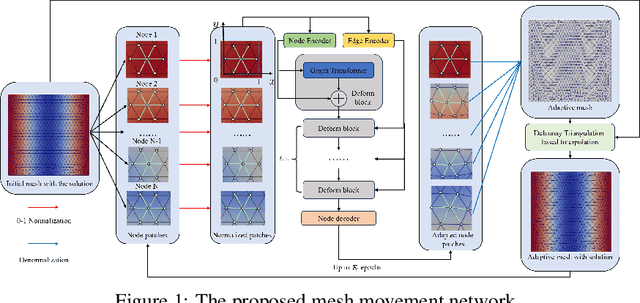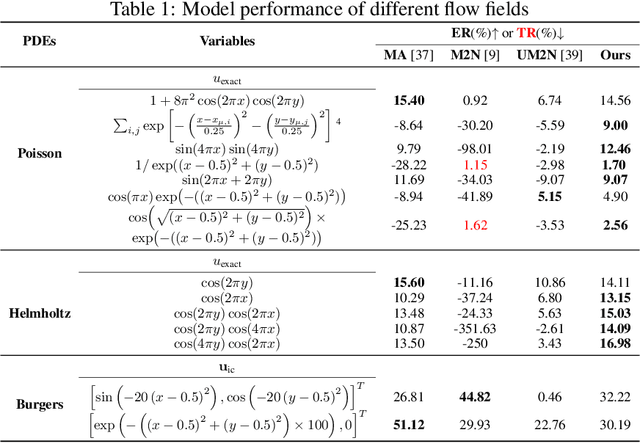Xiang Zhang
Victor
PhysWorld: From Real Videos to World Models of Deformable Objects via Physics-Aware Demonstration Synthesis
Oct 24, 2025Abstract:Interactive world models that simulate object dynamics are crucial for robotics, VR, and AR. However, it remains a significant challenge to learn physics-consistent dynamics models from limited real-world video data, especially for deformable objects with spatially-varying physical properties. To overcome the challenge of data scarcity, we propose PhysWorld, a novel framework that utilizes a simulator to synthesize physically plausible and diverse demonstrations to learn efficient world models. Specifically, we first construct a physics-consistent digital twin within MPM simulator via constitutive model selection and global-to-local optimization of physical properties. Subsequently, we apply part-aware perturbations to the physical properties and generate various motion patterns for the digital twin, synthesizing extensive and diverse demonstrations. Finally, using these demonstrations, we train a lightweight GNN-based world model that is embedded with physical properties. The real video can be used to further refine the physical properties. PhysWorld achieves accurate and fast future predictions for various deformable objects, and also generalizes well to novel interactions. Experiments show that PhysWorld has competitive performance while enabling inference speeds 47 times faster than the recent state-of-the-art method, i.e., PhysTwin.
C3Editor: Achieving Controllable Consistency in 2D Model for 3D Editing
Oct 06, 2025Abstract:Existing 2D-lifting-based 3D editing methods often encounter challenges related to inconsistency, stemming from the lack of view-consistent 2D editing models and the difficulty of ensuring consistent editing across multiple views. To address these issues, we propose C3Editor, a controllable and consistent 2D-lifting-based 3D editing framework. Given an original 3D representation and a text-based editing prompt, our method selectively establishes a view-consistent 2D editing model to achieve superior 3D editing results. The process begins with the controlled selection of a ground truth (GT) view and its corresponding edited image as the optimization target, allowing for user-defined manual edits. Next, we fine-tune the 2D editing model within the GT view and across multiple views to align with the GT-edited image while ensuring multi-view consistency. To meet the distinct requirements of GT view fitting and multi-view consistency, we introduce separate LoRA modules for targeted fine-tuning. Our approach delivers more consistent and controllable 2D and 3D editing results than existing 2D-lifting-based methods, outperforming them in both qualitative and quantitative evaluations.
TimeSeriesScientist: A General-Purpose AI Agent for Time Series Analysis
Oct 02, 2025



Abstract:Time series forecasting is central to decision-making in domains as diverse as energy, finance, climate, and public health. In practice, forecasters face thousands of short, noisy series that vary in frequency, quality, and horizon, where the dominant cost lies not in model fitting, but in the labor-intensive preprocessing, validation, and ensembling required to obtain reliable predictions. Prevailing statistical and deep learning models are tailored to specific datasets or domains and generalize poorly. A general, domain-agnostic framework that minimizes human intervention is urgently in demand. In this paper, we introduce TimeSeriesScientist (TSci), the first LLM-driven agentic framework for general time series forecasting. The framework comprises four specialized agents: Curator performs LLM-guided diagnostics augmented by external tools that reason over data statistics to choose targeted preprocessing; Planner narrows the hypothesis space of model choice by leveraging multi-modal diagnostics and self-planning over the input; Forecaster performs model fitting and validation and, based on the results, adaptively selects the best model configuration as well as ensemble strategy to make final predictions; and Reporter synthesizes the whole process into a comprehensive, transparent report. With transparent natural-language rationales and comprehensive reports, TSci transforms the forecasting workflow into a white-box system that is both interpretable and extensible across tasks. Empirical results on eight established benchmarks demonstrate that TSci consistently outperforms both statistical and LLM-based baselines, reducing forecast error by an average of 10.4% and 38.2%, respectively. Moreover, TSci produces a clear and rigorous report that makes the forecasting workflow more transparent and interpretable.
UrbanFeel: A Comprehensive Benchmark for Temporal and Perceptual Understanding of City Scenes through Human Perspective
Sep 26, 2025



Abstract:Urban development impacts over half of the global population, making human-centered understanding of its structural and perceptual changes essential for sustainable development. While Multimodal Large Language Models (MLLMs) have shown remarkable capabilities across various domains, existing benchmarks that explore their performance in urban environments remain limited, lacking systematic exploration of temporal evolution and subjective perception of urban environment that aligns with human perception. To address these limitations, we propose UrbanFeel, a comprehensive benchmark designed to evaluate the performance of MLLMs in urban development understanding and subjective environmental perception. UrbanFeel comprises 14.3K carefully constructed visual questions spanning three cognitively progressive dimensions: Static Scene Perception, Temporal Change Understanding, and Subjective Environmental Perception. We collect multi-temporal single-view and panoramic street-view images from 11 representative cities worldwide, and generate high-quality question-answer pairs through a hybrid pipeline of spatial clustering, rule-based generation, model-assisted prompting, and manual annotation. Through extensive evaluation of 20 state-of-the-art MLLMs, we observe that Gemini-2.5 Pro achieves the best overall performance, with its accuracy approaching human expert levels and narrowing the average gap to just 1.5\%. Most models perform well on tasks grounded in scene understanding. In particular, some models even surpass human annotators in pixel-level change detection. However, performance drops notably in tasks requiring temporal reasoning over urban development. Additionally, in the subjective perception dimension, several models reach human-level or even higher consistency in evaluating dimension such as beautiful and safety.
EVDI++: Event-based Video Deblurring and Interpolation via Self-Supervised Learning
Sep 10, 2025



Abstract:Frame-based cameras with extended exposure times often produce perceptible visual blurring and information loss between frames, significantly degrading video quality. To address this challenge, we introduce EVDI++, a unified self-supervised framework for Event-based Video Deblurring and Interpolation that leverages the high temporal resolution of event cameras to mitigate motion blur and enable intermediate frame prediction. Specifically, the Learnable Double Integral (LDI) network is designed to estimate the mapping relation between reference frames and sharp latent images. Then, we refine the coarse results and optimize overall training efficiency by introducing a learning-based division reconstruction module, enabling images to be converted with varying exposure intervals. We devise an adaptive parameter-free fusion strategy to obtain the final results, utilizing the confidence embedded in the LDI outputs of concurrent events. A self-supervised learning framework is proposed to enable network training with real-world blurry videos and events by exploring the mutual constraints among blurry frames, latent images, and event streams. We further construct a dataset with real-world blurry images and events using a DAVIS346c camera, demonstrating the generalizability of the proposed EVDI++ in real-world scenarios. Extensive experiments on both synthetic and real-world datasets show that our method achieves state-of-the-art performance in video deblurring and interpolation tasks.
PosterGen: Aesthetic-Aware Paper-to-Poster Generation via Multi-Agent LLMs
Aug 24, 2025Abstract:Multi-agent systems built upon large language models (LLMs) have demonstrated remarkable capabilities in tackling complex compositional tasks. In this work, we apply this paradigm to the paper-to-poster generation problem, a practical yet time-consuming process faced by researchers preparing for conferences. While recent approaches have attempted to automate this task, most neglect core design and aesthetic principles, resulting in posters that require substantial manual refinement. To address these design limitations, we propose PosterGen, a multi-agent framework that mirrors the workflow of professional poster designers. It consists of four collaborative specialized agents: (1) Parser and Curator agents extract content from the paper and organize storyboard; (2) Layout agent maps the content into a coherent spatial layout; (3) Stylist agents apply visual design elements such as color and typography; and (4) Renderer composes the final poster. Together, these agents produce posters that are both semantically grounded and visually appealing. To evaluate design quality, we introduce a vision-language model (VLM)-based rubric that measures layout balance, readability, and aesthetic coherence. Experimental results show that PosterGen consistently matches in content fidelity, and significantly outperforms existing methods in visual designs, generating posters that are presentation-ready with minimal human refinements.
Creative4U: MLLMs-based Advertising Creative Image Selector with Comparative Reasoning
Aug 18, 2025Abstract:Creative image in advertising is the heart and soul of e-commerce platform. An eye-catching creative image can enhance the shopping experience for users, boosting income for advertisers and advertising revenue for platforms. With the advent of AIGC technology, advertisers can produce large quantities of creative images at minimal cost. However, they struggle to assess the creative quality to select. Existing methods primarily focus on creative ranking, which fails to address the need for explainable creative selection. In this work, we propose the first paradigm for explainable creative assessment and selection. Powered by multimodal large language models (MLLMs), our approach integrates the assessment and selection of creative images into a natural language generation task. To facilitate this research, we construct CreativePair, the first comparative reasoning-induced creative dataset featuring 8k annotated image pairs, with each sample including a label indicating which image is superior. Additionally, we introduce Creative4U (pronounced Creative for You), a MLLMs-based creative selector that takes into account users' interests. Through Reason-to-Select RFT, which includes supervised fine-tuning with Chain-of-Thought (CoT-SFT) and Group Relative Policy Optimization (GRPO) based reinforcement learning, Creative4U is able to evaluate and select creative images accurately. Both offline and online experiments demonstrate the effectiveness of our approach. Our code and dataset will be made public to advance research and industrial applications.
UGM2N: An Unsupervised and Generalizable Mesh Movement Network via M-Uniform Loss
Aug 12, 2025



Abstract:Partial differential equations (PDEs) form the mathematical foundation for modeling physical systems in science and engineering, where numerical solutions demand rigorous accuracy-efficiency tradeoffs. Mesh movement techniques address this challenge by dynamically relocating mesh nodes to rapidly-varying regions, enhancing both simulation accuracy and computational efficiency. However, traditional approaches suffer from high computational complexity and geometric inflexibility, limiting their applicability, and existing supervised learning-based approaches face challenges in zero-shot generalization across diverse PDEs and mesh topologies.In this paper, we present an Unsupervised and Generalizable Mesh Movement Network (UGM2N). We first introduce unsupervised mesh adaptation through localized geometric feature learning, eliminating the dependency on pre-adapted meshes. We then develop a physics-constrained loss function, M-Uniform loss, that enforces mesh equidistribution at the nodal level.Experimental results demonstrate that the proposed network exhibits equation-agnostic generalization and geometric independence in efficient mesh adaptation. It demonstrates consistent superiority over existing methods, including robust performance across diverse PDEs and mesh geometries, scalability to multi-scale resolutions and guaranteed error reduction without mesh tangling.
VertexRegen: Mesh Generation with Continuous Level of Detail
Aug 12, 2025Abstract:We introduce VertexRegen, a novel mesh generation framework that enables generation at a continuous level of detail. Existing autoregressive methods generate meshes in a partial-to-complete manner and thus intermediate steps of generation represent incomplete structures. VertexRegen takes inspiration from progressive meshes and reformulates the process as the reversal of edge collapse, i.e. vertex split, learned through a generative model. Experimental results demonstrate that VertexRegen produces meshes of comparable quality to state-of-the-art methods while uniquely offering anytime generation with the flexibility to halt at any step to yield valid meshes with varying levels of detail.
Capsizing-Guided Trajectory Optimization for Autonomous Navigation with Rough Terrain
Aug 11, 2025Abstract:It is a challenging task for ground robots to autonomously navigate in harsh environments due to the presence of non-trivial obstacles and uneven terrain. This requires trajectory planning that balances safety and efficiency. The primary challenge is to generate a feasible trajectory that prevents robot from tip-over while ensuring effective navigation. In this paper, we propose a capsizing-aware trajectory planner (CAP) to achieve trajectory planning on the uneven terrain. The tip-over stability of the robot on rough terrain is analyzed. Based on the tip-over stability, we define the traversable orientation, which indicates the safe range of robot orientations. This orientation is then incorporated into a capsizing-safety constraint for trajectory optimization. We employ a graph-based solver to compute a robust and feasible trajectory while adhering to the capsizing-safety constraint. Extensive simulation and real-world experiments validate the effectiveness and robustness of the proposed method. The results demonstrate that CAP outperforms existing state-of-the-art approaches, providing enhanced navigation performance on uneven terrains.
 Add to Chrome
Add to Chrome Add to Firefox
Add to Firefox Add to Edge
Add to Edge